Green Fodder Production Guide:
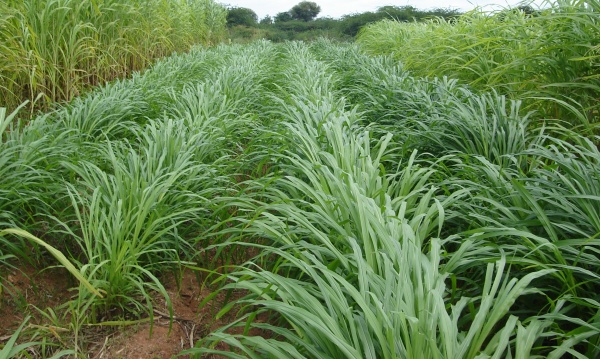
Introduction of Green Fodder Production:- Green fodder plays major role in feed of milch animals, thereby providing required nutrients for milk production and health of the dairy animals. Green fodder production provides the better option of feed buying alternative for farmers who are planning to go for sheep farming, goat farming or dairy farming. Some farmers even depend on the cultivation of green fodder just like any other crop and sell it in the market. Some types of green grasses can be chopped into pieces using local chop cutting machine and make silage which can be stored for years and used as fodder in dry or drought seasons. Green fodder can be cultivated in open fields choosing right hybrid perennial variety. Green fodder even can be grown using hydroponics system.
What is Green Fodder?:- Any feed that is made from green crop like legume crops, grass crops, cereal crops or tree based crops is called green fodder. There are mainly three types of green fodders available. Legume crop based, cereal crop based and tree based.
Objectives of Green Fodder Production in Agriculture:- The following are the primary functions of Green Fodder.
- Green fodder provides natural way of nutrients for animals and plays major role in livestock growth and health.
- Green fodder cultivation cut the cost of feed.
- Produced green fodder can be made into silage and used for future.
- Green fodder production time is short and as most of the varieties are perennial, one can get fodder for years.
- Cultivation cost and maintenance of green fodder is low.
Types of Green Fodder:- The following are the types of Green Fodder. These are different types of fodders to achieve a common result based on different types of plants.
- Legume Fodder.
- Cereal Fodder.
- Grass Fodder.
- Tree Fodder.
Green Fodder Production from Legume Crops:-
1) Cowpea:
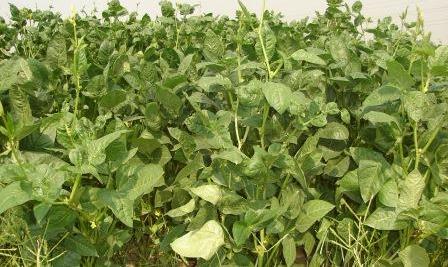
- Cowpea is an annual crop and this can be grown in grown in tropics, sub-tropics and warm temperature regions.
- Cowpea is useful for feeding in green form, for hay making or for ensiling in mixtures with sorghum or maize.
- CO 5 cultivar suitable for growing under irrigated conditions.
- This crop can be cultivated during Kharif, Rabi and summer seasons.
- Cowpea can be cultivated throughout the year.
- The main cultivars of cowpea include Co 5, Russian giant, EC 4216, UPC – 287 and some local cultivars.
- Generally, it takes about 40 to 45 kg/ha seed rate.
- Cowpea can be harvested after 45 to 50 days after sowing (40 to 50% flowering stage).
C05 Variety highlights:
- This variety yields the green fodder of 20 tonnes/ha.
- Plant height is about 95 cm (cm) and posses 2 to 3 branches and 10 to 12 leaves.
- This cultivar has a habit of semi spreading.
2) Stylo:
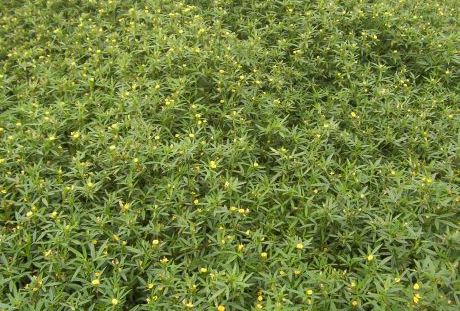
- Stylo is an erect growing perennial forage legume crop and this forage is native to Brazil.
- Generally, stylo reaches height of 2 meters.
- Stylo is drought resistant and a good pasture legume crop and it requires low rain fall.
- Stylo can be grown in tropical climate. This crop is tolerant to low fertility soils acidic soils and soils with poor drainage.
- The crude protein content of stylo ranges from 16% to 18%.
- The best season for stylo is June – July to Sept – Oct months.
- When it comes to seed rate, for line sowing @ 30 x 15 cm, the required seed rate is 6 to 7 kg/ha and for broadcasting 10 to 11 kg/ha.
- Stylo will be ready for harvesting 70 to 75 days after sowing at flowering stage and subsequent harvests depending upon the growth.
- During the first year (establishment phase) of crop, low yield can be expected and subsequent yield would be high and yield of 25 to 40 tons/ha/year can be obtained from 3rd year.
3) Desmanthus:
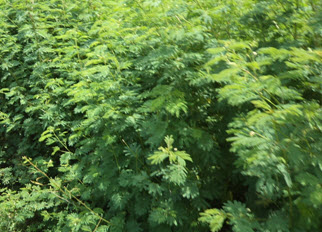
- This crop is a perennial one and can grow all around the year. This crop can be grown under rainfed and irrigated conditions.
- This crop requires 18 to 20 kg of seeds per hectare and seeds should be sown in solid stand on the side of the ridges dug over the lines where manures and fertilizers are applied @ 2 cm depth. Make sure the seeds are covered with top soil. Irrigation should be carried immediately after sowing the seeds. Life irrigation should be given on 3rd day and subsequent watering should be provided once in 6 to 7 days. It does not require any irrigation in rainy season.
- This crop will be ready for first harvest in 3 months after sowing when it is 45 to 50 cm height. Subsequent harvesting should be done @ 35 to 40 days interval depending on the growth.
- Green fodder yield of 80-90 tons/ha/year can be obtained.
4) Lucerne:
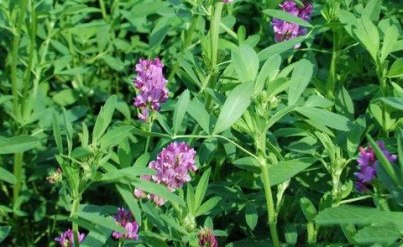
- Lucerne is popularly known as queen of forages and this legume crop is deep rooted perennial forage grown on wide range of climatic conditions ranging from tropical to alpine.
- Lucerne very palatable and nutritious green fodder and contains about 15% to 20% crude protein on dry matter basis.
- Apart from all these benefits, Lucerne adds nitrogen to soil and improves soil fertility.
- This crop is usually grown for green fodder, hay, silage. However it does not tolerate close grazing.
- The main Lucerne varieties are Anand -2, Sirsa-9, IGFRI S – 244, and Co 1.
- Seeds rate of 18 to 20 kg/ha are required.
- Co1 cultivar is suitable to grown in July-Dec months and not preferred to grow in extreme hot and extreme cold climates.
- The first cutting will be ready 70 – 80 days after sowing and subsequent harvests can be made @ 21 to 30 days.
Green Fodder Production from Cereal Crops:-
1) Maize (Corn) Fodder:
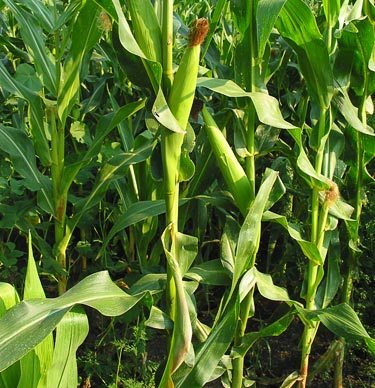
- Basically maize is an annual crop and can be cultivated on variety of soils, for complete maize farming info, Read here.
- The prime varieties of maize are African tall, Vijay composite, Moti composite, Ganga-5 and Jawahar.
- This crop requires a seed rate of 40 to 45 kg/ha and dibble one seed to a spacing of 15cm between the seeds in the row which are 30 cm apart.
- The average green fodder yield of 45-50 tons/ha and the dry matter yield is 10-15 tones/ha can be obtained.
- Staggered sowing is recommended for supply of green fodder for a long period.
- Usually it comes to harvesting stage in 2 months when the cob is in the milky stage.
2) Sorghum Fodder – Jowar:
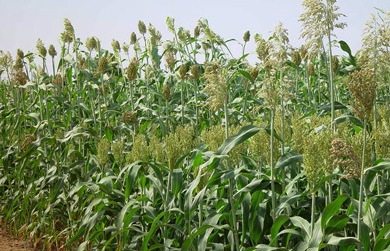
- This crop is cultivated for both grain and fodder.
- Sorghum is a drought resistant annual crop and grows well in tropical areas with a temperature range of 25-36°C.
- This crop requires an annual rainfall of 300- 400 mm. It can be cultivated on wide range of soils, however too much sandy soils should be avoided.
- Sorghum varieties for Irrigated conditions are Co.11, Co. 27 and Co.F.S. 29.
- Sorghum varieties for Rainfed conditions are Co.11, Co27, Co.F.S.29, K7, Co.27, Co.F.S. 29 and K 10.
- This crop requires seed rate is 40 to 45 kg/ha and 12 to 13 kg/ha for Co.F.S. 29 varieties.
- This crop can be harvested after flowering stage for green fodder.
- If it is a single cut, it should be harvested at 60-65 days (50% flowering) after sowing and if it is a multi-cut, the first cut is 2 months after sowing and subsequently once in 45 days.
- For Co. F.S. 29, each harvest should be done at 65 days interval (5 harvests in a year).
For complete Sorghum (Jowar) Farming: Read here.
Green Fodder Production from Grass Crops:-
1) Hybrid Napier Fodder:
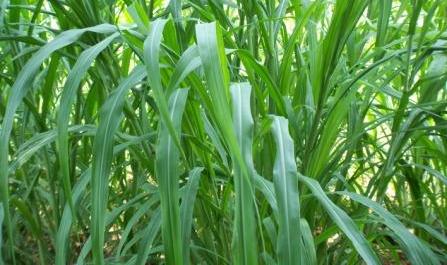
- Basically, this is a perennial grass fodder and possesses more tillers and leaves than Napier grass and is more vigorous and yielding and quality is higher.
- This crop contains crude protein from 8 to 10%.
- Main varieties of hybrid Napier grass are, Pusa Giant, IGFRI 5, NB 21, NB 37, IGFRI 7 and IGFRI 10.
- Co1, Co2 and Co3 are also superior varieties and are suitable for growing throughout the year.
- Usually 40,000 to 45,000 slips should be required to plant in one hectare land.
- First cutting should be done on 70to 80 days after planting and subsequent cuttings at intervals of 40 to 45 days.
- Hybrid Napier grass can be intercropped with Desmanthus at 3:1 ratio and can be harvested together and fed to livestock.
2) Guinea Grass:
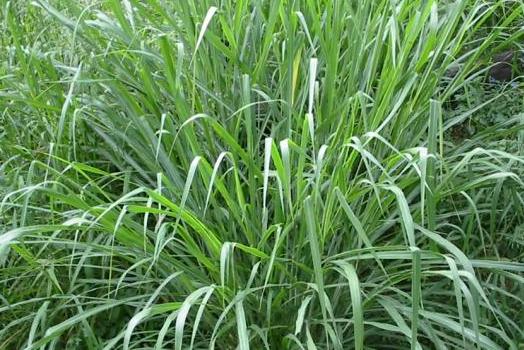
- This grass reaches about 5 meter tall and tufted and fast growing highly palatable perennial grass.
- It has short creeping rhizome and establishes readily with seed or plantation of rooted slips.
- This grass contains crude protein of 4-15%.
- The main cultivars of this grass are Hamil, PPG -14, Makuni and Rivers-dale.
- This grass can be grown in all types of soil with well-drainage. However, it does not grow well on heavy clay soil or flooded or stagnation conditions.
- This crop requires seed rate of 2 to 2.5 kg/ha and slips of 65,000 nos./ha which accommodates spacing of 50 cm x 30 cm.
- Usually, the first harvest will be ready in 70- 80 days after germination or 40 to 45 days after planting of slips. Subsequent cuts should be carried out at intervals of 40 to 45 days.
- Green fodder yield of 17- 180 tonnes /ha per year in 8 cuts can be obtained.
- Guinea grass can be intercropped with Hedge Lucerne at 3:1 ratio and can be harvested together and fed to livestock.
3) Para Grass:
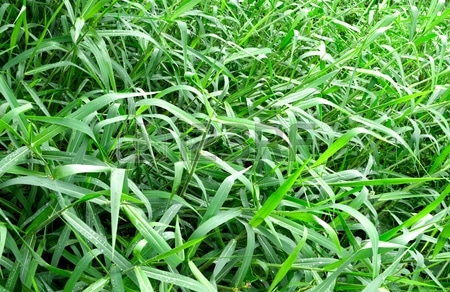
- This grass forage is a perennial and ideal for growing in humid climatic conditions.
- This can be cultivated in seasonally flooded valleys and lowlands. This grass can withstand water stagnation and long term flooding as well.
- Avoid dry lands in arid or semi arid regions as it does not thrive in these type of soils.
- This grass is sensitive to cold and the growth is adversely affect in sub-tropical regions.
- It prefers water logged soils for high yielding of green fodder. It can also thrives in sandy soils.
- The disadvantage of this grass cultivation is, seed setting is very poor and is propagated exclusively by stem cuttings.
- This can planted anytime during the year provided there is sufficient irrigation is available.
- In this grass, there are no hybrid cultivars available.
- Thin shoots should be used as planting material and stems with 2-3 nodes should be planted in 45 to 60 cm rows at 20 cm distance. The stems should be pressed into wet soil leaving the two ends sticking up.
- 900-1000 kg of stem cuttings should be required for planting in one hectare field.
- The first harvest will be ready in 70-80 days after planting and the subsequent cuts should be given at 40 to 45 days interval. There would be totally 6 to 9 cuts can be taken in a year with an average green fodder yield of 90-100 tons/ha.
- Usually, this grass is fed in the green form and is not good for conservation either as hay or as silage.
4) Blue-Buffel Grass:
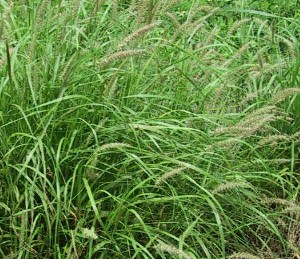
- This type of grass suitable for pasture land and it is a perennial.
- Well drained soil with high calcium content is suitable for this grass cultivation.
- This crop requires seed rate of 5 to 7 kg/ha.
- Generally, first cut can be made 70 to 75 days after sowing and subsequently 4 to 5 cuts depending on growth.
- This grass crop can yield up to 35 tons/ha/year in 4 to 5 cuts.
Green Fodder Production from Tree Crops:
1) Subabul Fodder:
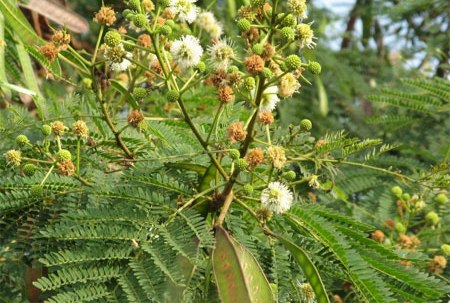
- This is one of the fastest growing fodder trees and produces maximum seeds.
- The best time for sowing these plants is in the month of June-July.
- The main subabul varieties include- Hawaiian giant and Co1.
- Suitable cultivars for rainfed conditions are K 8, Giant lpil – lpil and Co 1.
- These plants will be ready for first cutting in as early as 6 months after planting the seeds. However, the initial cutting should not be done until the trunk has attained at least 3 cm in diameter or the plant has completed one seed production cycle.
- Subsequent cuttings can be carried once in 45 – 80 days depending upon growth and season.
- In case of drought regions, allow the trees to grow for 2 years to ensure deep root penetration.
- The trees should be at 95 to 100 cm height from ground level.
- Under irrigated conditions, a green fodder of 90 to 100 tons/ha can be obtained.
- Under rainfed conditions 40 tons/ha of green fodder can be achieved.
2) Sesbania Fodder – Agathi:
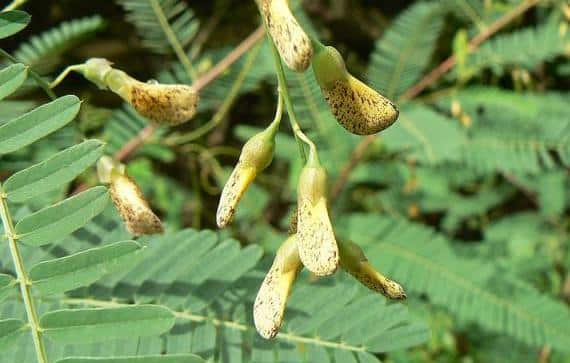
- The leaves of Agathi trees are highly palatable and mostly liked by goats.
- This tree leaves contain protein content of 20 to 25%.
- These trees can be grown all around the year provided there is a sufficient irrigation available.
- These trees thrive best in soils with good drainage and organic matter.
- This crop requires seed rate of 7 to 8 kg /ha, seeds should be sown at a distance of 100 cm x 100 cm (100 cm between ridges and 100 cm between plants within the ridge).
- The first harvest will be ready after 7 to 8 months and subsequent harvests can be done at an interval of 70-80 days depending on the growth.
- These trees can produce green fodder of 90 to 100 tonnes per/ha/year.
3) Gliricidia Fodder:
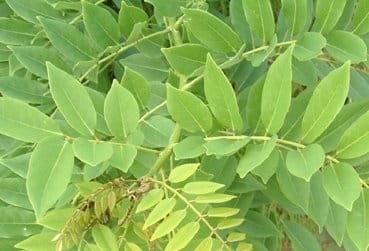
- This tree is a small and semi-deciduous tree with pale bark.
- Glyricidia sepium and Gliricidia maculata are the two species available and Gliricidia maculata is more useful as green leaf manure. It also fixes atmospheric nitrogen in the soil.
- Glyricidia sepium tolerates a wide range of climatic conditions. Growth of this tree is fast in areas where annual rainfall exceeds 850 mm, but it can grow well where rainfall is as low as 400 mm.
- The tree prefers soils ranging from heavy clays to sands and on rocky eroded sites; however, it is sensitive to water stagnation so drainage is very important.
- The plant is used for fuel wood, animal feed, green manure, shade, poles, and living fences and as support plants.
- These plants are generally propagated through seed or cuttings.
- This produces fresh growth after every cutting of the leaves. it will supply enough green leaf manure for 2 to 2.5 tonnes/ hectares of land.
Bottom Line of Green Fodder Production:- Green fodder production is best way of providing daily feeding requirements in livestock.
For silage making process: Read here.
For sheep farming or goat farming: Read here.
For Asia farming guide: Read here.
Pls inform about kharif cattle crops for Sandy soil in Pune hills
Jagdhishji,
very good information about green fodder. you produce these fodder at your farm where irrigation reaches.Do you have rain fed land, wasteland ? what do you grow on that land?
please go for rain fed, palatable and nutritious indigenous grasses like Sehima nervosum, Dichanthium annulatum, D.caricosum, Cenchrus ciliaris,C setigerus. Also plant fodder trees so that cost of feeds and feeding will reduce.
Good information for fodder crop
We want to grow grass in Ahmedabad (dry area but we have bore water through out the year).
This is required for old cows, which do not give milk & we take care of this types of cows, which are abandoned by farmers are they stop giving milk.
Kindly suggest appropriate grass.We have @ 1400 cows.
Thanks,very nicely described.